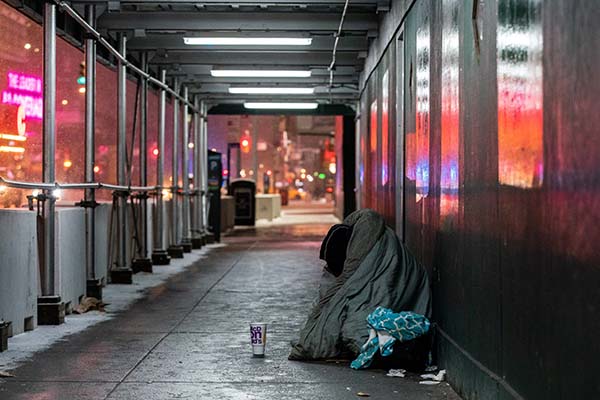
WINDSOR TERRACE — Ask Vincent Nerone about the homeless population on the streets of New York since the COVID-19 pandemic hit the city, and he doesn’t hesitate.
“There’s definitely more people out there,” said Nerone, a volunteer with a homeless outreach program at St. Dominic Church in Bensonhurst.
[Related: Mayoral Hopefuls Stake Out Positions on Homelessness]
Three times a month, Nerone and a group of St. Dominic parishioners take a van into Manhattan to bring food and clothing to homeless people, making several stops along the way.
Before the pandemic, he says, they would likely encounter between 30 and 50 people in all. Now, it’s not unusual for them to see 50 people at just their first stop — Madison Avenue and 30th Street.
Yet city officials contend the population of people experiencing homelessness has decreased since the start of the pandemic.
According to the Department of Social Services (DSS), an umbrella agency that includes the Department of Homeless Services (DHS), there are approximately 45,000 people currently living in the city’s system of shelters, compared to March 2020, when there were approximately 57,000.
Ian Martin, deputy press secretary for DSS, noted that families with children make up the majority of people experiencing homelessness in the shelter system but said that even those numbers are falling.
Over the past several years, New York City has achieved significant declines in the number of homeless families residing in shelters on any given night, Martin said in an email to The Tablet. He reported the peak number of individual family members “declining by more than 18,000 between 2014 and today.”
The Homeless Outreach Population Estimate (HOPE), an annual survey in which volunteers trained by DHS hit the streets to take a headcount, indicated a decline this year. The survey, conducted in January, found 2,376 people on the streets, down from the 2020 HOPE count of 3,857 in the comparable period.
The number of homeless on the street dropped 38% between 2020 and 2021, the city said. There are also 23% fewer people sleeping in the subways, officials contend.
But the city’s figures have been met with a great deal of skepticism on the part of advocates for the homeless and grassroots groups.
According to the Coalition for the Homeless, on any given night 50,000 people are sleeping in city shelters — the most since the Great Depression.
Advocates point out that the numbers the city is touting could be misleading because they don’t take into account the city’s sweeps, known as “cleanups,” in which the homeless are chased out of the subways and public areas on a regular basis.
Nerone, who has been an outreach volunteer for 10 years, is also skeptical of the city’s numbers.
“I think they should leave their office and go out to the street to see what’s really going on,” he said.
Meanwhile, churches in the Diocese of Brooklyn are providing homeless support services at the grassroots level.
Every Wednesday, a group of volunteers from Our Lady of Grace in Gravesend drive to Brighton Beach-Coney Island to hand out food to the homeless.
“I have a group of 12 people who are very dedicated. They go to Brighton 4th Street on the Boardwalk. There’s a parking lot … the city lets us use,” said Angela Bonvino, a parishioner who leads the outreach effort.
“We make a hot meal for the homeless people. For many of them, that’s their main meal of the day,” she added. “They also get fruit and coffee. We have snacks for them, too — what you would give if you had a relative coming over.”
The volunteers from St. Dominic also take their mission seriously. They pack their van with clothing, blankets, deodorant, toothpaste, toothbrushes, socks, underwear, razors, and other essentials. They also hand out home-cooked meals.
Nerone said some outreach groups distribute peanut butter and jelly sandwiches to the homeless, “but we want them to have a nice meal.”
According to Nerone, the important thing is to see the homeless as people.
“I’ve been doing this for 10 years, so I built relationships with them,” he said. “They just have issues of bad luck — poor decisions, losing a job — and now they’re stuck on the streets.”
Msgr. David Cassato, pastor of St. Athanasius-St. Dominic Parish, Bensonhurst, said it’s important for Catholics to help the less fortunate.
“It’s a Gospel mandate,” he said. “Remember, Jesus said: ‘Whatever you do to the least of my brothers, you do unto me.’ ”
